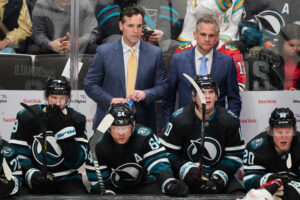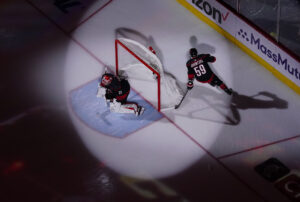Over the last several months, I have been crunching numbers, trying to solve the many questions of NHL prospects development. With that, we here at Last Word On Hockey will be starting a new series on how to properly develop prospects from all different spots throughout the draft.
Player Developments of NHL Prospects
From 2005-2015, there have been 24 draft picks used on forwards from North American junior teams in the top-three. The focus was directly on North American prospects for the sake of comparing stats. I separated those 24 forwards from the rest of the top-three picks in that span. Then, I looked at their DY-1 stats, the season before they get drafted, and their DY stats. I averaged out their points per game in their DY-1, DY and beyond, if necessary, and color-coded them. The four sections were “well-above average,” “above average,” “below average” and “well-below average.”
Based on the sections they landed on before they played 15 or more games in an NHL season, they were separated into categories. The categories were “Forwards deemed NHL Ready,” “Forwards nearly NHL Ready,” “Slightly Rushed,” “Rushed,” “Forced,” “Teams were Patient,” and “Teams were way too patient.” There were five forwards who landed in the near NHL ready grouping and were called up immediately. Those players were Steven Stamkos, John Tavares, Taylor Hall, Nathan MacKinnon, and Jack Eichel. Four of the five players posted one well-above average and one above average junior season, while one (MacKinnon) posted back-to-back above average seasons. In this piece, we will focus on Stamkos and Tavares.
You can read about MacKinnon, Hall, and Eichel here.
Player Development of Steven Stamkos
Steven Stamkos was the first one selected of the bunch, in chronological order. He posted a well-above average point per game total in his DY-1 season, posting a 1.46 mark. He followed that up with a better season in his DY, but relative to other top 3 selections, his improved point total only registered as above average. His mark in his DY was 1.721 points per game. He was immediately called up.
How was Stamkos used?
Obviously, NHL prospects development does not stop once the player makes the NHL level. So, how did the Tampa Bay Lightning utilize Stamkos once he made the jump? Well, in his rookie year, he slotted into 79 of 82 games, and averaged 14:56 time on ice. In a limited role, Stamkos would record 23 goals and 23 assists for 46 points. For the more analytically inclined readers, Stamkos registered a 3.3 Even-strength offense (EVO), -2.1 Even-strength defense (EVD), a 0.9 win above replacement (WAR), and a 5 goals above replacement (GAR). Those advanced numbers are fairly pedestrian, but for a rookie, it certainly isn’t bad.
In his second season, Stamkos played in all 82 games. He scored 51 goalsand 44 assists for 95 points en route to a Maurice Richard Trophy for leading goal-scorer of the 2009-10 NHL season. Stamkos did this all while averaging 20:33 time on ice per game, a massive leap from his rookie year. His EVO jumped to 13.5 while his EVD dropped to -5.8. Meanwhile, he posted a 2.9 WAR and a 15.9 GAR.
Finally, in his third NHL season, Stamkos yet again played a full 82-game season. He posted 45 goals and 46 assists for 91 points, a slight step back from the year prior. Averaging slightly less time on ice could be to blame, as it went down to 20:12 per game. However, Stamkos took a turn for the better defensively, which resulted in a rise in most of his analytics. His EVO went down to 11.9, which is still really good, but his EVD rose drastically to a 1.9. Due to his defensive improvements, his WAR went up to 4.2 and his GAR rose to a 23.7 mark.
Player Development of John Tavares
In the OHL, Tavares posted an absurd DY-1 points per game mark. He finished with a 2 point per game mark. He followed that up with a slight step back, with a 1.857 point per game mark. His DY-1 season was deemed well-above average, while his DY was considered above average. He was called up immediately following the draft to play for the New York Islanders.
How was Tavares used?
In his rookie year, Tavares played a full 82 game season, averaging 18 minutes of ice time per game. He scored 24 goals and 30 assists for 54 points. Those numbers are solid for a rookie, but certainly not anywhere near the level that Stamkos produced at. Analytically, however, Tavares compared almost equally to Stamkos. Tavares posted a 6 EVO, a -6.4 EVD, a 0.9 WAR and a 4.9 GAR.
In his second season, Tavares played 79 games, scoring 29 goals and 38 assists for 67 points. He averaged 19:15 of ice time, over a full minute more than the year prior. His advanced stats rose at even-strength, but he had a decline in the more telling areas. His EVO was at 6.8, and his EVD was better but still not good at -5.1. Meanwhile, his WAR dropped to 0.7 and his GAR dropped to 3.7.
Despite his statistical drop, the Islanders did not lose faith in Tavares. In fact, in his third season, Tavares was given a larger role. He averaged 20:34 time on ice per game, over a span of 82 games. He scored 31 goals and 50 assists for 81 points because of it. His EVO drastically rose to an 11.3 mark, while his EVD numbers continued to slowly rise, as he was given a -2.4 mark there. Meanwhile, his WAR rose significantly to 3.3 and his GAR did as well, generating an 18.8 mark in that stat. Again, despite his year two struggles, the Islanders stayed the course and reaped the benefits.
Player Development For These Two Star NHL Prospects
As mentioned in the last player development article, it’s very difficult to whiff on a top 3 pick. However, the two aforementioned players had varying levels of success. After their first three years, Tavares registered the biggest role, followed by Stamkos. Analytically in each of their first three years, Stamkos was the best, with Tavares finishing last.
In their careers, Stamkos has the highest EVO per 60 score, the highest EVD/60, the highest GAR/60 and WAR/60 as Tavares followed well behind.
Roles in their first three years didn’t make a difference?
Looking at who finished with the largest role in their first three years to the analytics, it simply doesn’t add up. Tavares had the biggest role, but finished at the bottom of every category to Stamkos. So, what happened?
Tavares has been extremely consistent each and every year, both statistically with basic stats, and analytically, with the numbers used above.
So, what happened to Tavares and his big role?
Tavares was traded, after he was given a large role with his original team, and that allowed him to turn into a solid first line center. However, he is at the low-end of the elite tier of top-line centers, at least with the Islanders. When he came to the Leafs, he was 28-years-old and already established. They lessened his role, due to the sheer amount of elite forwards in their possession. This allowed him to have less weight on his shoulders.
With the smaller role after already having established himself, his stats improved. So the trade did not have any setbacks on his analytics. It was simply a case of not having much help around him. The Islanders never got Tavares a high-end linemate. Meanwhile, Stamkos, has had Nikita Kucherov, Martin St. Louis and Brayden Point, respectively, at points throughout his career.
The Islanders groomed Tavares perfectly, but did not build around him effectively. He left for Toronto, where they are already built at the forward positions. He has thrived in that role with Toronto. That is why Tavares did not compare favorably to the aforementioned NHL prospects, despite the immediate role.
Main Photo:






